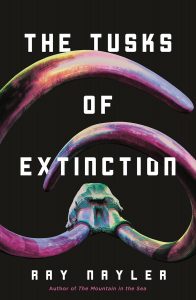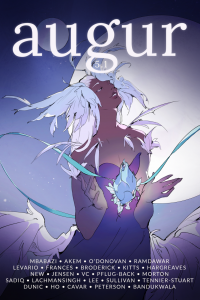Gary K. Wolfe Reviews The Tusks of Extinction by Ray Nayler
 The Tusks of Extinction, Ray Nayler (Tordotcom 978-1-25085-552-7, $26.99, 112pp, hc) January 2024.
The Tusks of Extinction, Ray Nayler (Tordotcom 978-1-25085-552-7, $26.99, 112pp, hc) January 2024.
Just over a year ago, Ray Nayler offered us a brilliantly original glimpse into the minds of octopuses in The Mountain in the Sea, making a convincing case that this was about as close as we’ve come to encountering a genuine alien intelligence. With The Tusks of Extinction, he turns his attention to the minds of woolly mammoths, who aren’t nearly as alien, but the overall tone and focus of this powerful novella is quite a bit different. The mammoths in question have been reintroduced to the tundra by means of a Russian de-extinction project not unlike some actual proposals that have been in the news lately, but it’s not long before well-organized and well-funded poachers begin slaughtering them for ivory – just as they had done to elephants for centuries. The scenes involving poaching, both of elephants and mammoths, are deliberately brutal and shocking, and the sense of rage is both palpable and contagious, made the more intense by the story’s compressed length and limited number of characters.
As with The Mountain in the Sea, Nayler isn’t content with just one SF high concept. We first meet Damira, an authority on elephant behavior and a crusader against poaching, as she comes across a group of slaughtered elephants. ‘‘Their trunks were hacked away, their tusks gouged out, their feet chopped off.’’ A newborn calf ‘‘had stayed with the buzzing ruins of her mother and her clan, and lay down to die just a few days after coming into the world.’’ A few years later, Damira herself is murdered by poachers – but not before her consciousness is uploaded into something called the Mind Bank, a way of preserving and archiving ‘‘Our National Intellectual Wealth.’’ When Damira is awakened a century later by a Dr. Aslanov, she learns not only of her own murder (remember, the download happened earlier), but of the extinction of elephants in the wild and the project to restore mammoths to the tundra. The project is faltering, however, and Aslanov believes Damira is ‘‘the only existing mind of any kind that knows the culture of elephants.’’ His proposal is to download her mind into the body of one of the mammoths, hoping that with her knowledge she can ‘‘teach them how to be mammoths.’’ In fact, what she ends up doing is once again fighting poachers, only this time from the point of view of the mammoths themselves.
There’s an unavoidable whiff of speciesism in any suggestion that humans can teach animals how to be animals, and something pretty unlikely about the idea of downloading a human personality into a nonhuman brain, but it does give Nayler the opportunity to narrate some chapters from the split perspective of Damira-as-mammoth, and as a literary device it’s probably no more problematical than Stephen Baxter’s anthropomorphized intelligent mammoths of his Mammoth trilogy of 1999-2001. An almost equally bold move is to narrate other chapters from the point of view of one of the despised poachers, a boy named Svyatoslav, who unwillingly accompanies his father and his drunken companions on poorly planned get-rich-quick expeditions. There’s no actual sympathy for the poachers in these chapters – and there are some pretty violent comeuppances – but there is a suggestion that poverty and desperation may play a role in poaching along with the obvious greed and casual contempt for life. Both Damira and Svyatoslav’s viewpoints are designed to leave you with a sense of outrage at the depths and crudeness of that greed, and that’s exactly where Nayler wants you. In the end, Tusks of Extinction is a passionate screed, and a necessary one.
Gary K. Wolfe is Emeritus Professor of Humanities at Roosevelt University and a reviewer for Locus magazine since 1991. His reviews have been collected in Soundings (BSFA Award 2006; Hugo nominee), Bearings (Hugo nominee 2011), and Sightings (2011), and his Evaporating Genres: Essays on Fantastic Literature (Wesleyan) received the Locus Award in 2012. Earlier books include The Known and the Unknown: The Iconography of Science Fiction (Eaton Award, 1981), Harlan Ellison: The Edge of Forever (with Ellen Weil, 2002), and David Lindsay (1982). For the Library of America, he edited American Science Fiction: Nine Classic Novels of the 1950s in 2012, with a similar set for the 1960s forthcoming. He has received the Pilgrim Award from the Science Fiction Research Association, the Distinguished Scholarship Award from the International Association for the Fantastic in the Arts, and a Special World Fantasy Award for criticism. His 24-lecture series How Great Science Fiction Works appeared from The Great Courses in 2016. He has received six Hugo nominations, two for his reviews collections and four for The Coode Street Podcast, which he has co-hosted with Jonathan Strahan for more than 300 episodes. He lives in Chicago.
This review and more like it in the December and January 2023 issue of Locus.
 While you are here, please take a moment to support Locus with a one-time or recurring donation. We rely on reader donations to keep the magazine and site going, and would like to keep the site paywall free, but WE NEED YOUR FINANCIAL SUPPORT to continue quality coverage of the science fiction and fantasy field.
While you are here, please take a moment to support Locus with a one-time or recurring donation. We rely on reader donations to keep the magazine and site going, and would like to keep the site paywall free, but WE NEED YOUR FINANCIAL SUPPORT to continue quality coverage of the science fiction and fantasy field.
©Locus Magazine. Copyrighted material may not be republished without permission of LSFF.






